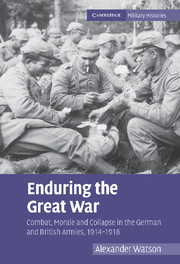Book contents
- Frontmatter
- Contents
- List of plates
- List of figures
- List of tables
- Acknowledgements
- List of abbreviations
- Map: The Western Front 1914–1918
- Introduction
- 1 War of endurance
- 2 Why men fought: combat motivation in the trenches
- 3 Self-deception and survival: mental coping strategies
- 4 Junior leadership: command, cohesion and combat motivation
- 5 Morale and military endurance
- 6 The German collapse in 1918: strike, mutiny or an ordered surrender?
- Conclusion
- Appendix 1 Walter Ludwig's study of Württemberg soldiers' coping strategies
- Appendix 2 Psychiatric casualties in the German and British armies
- Appendix 3 Military ranks and status in the German and British armies
- Glossary of German terms
- Bibliography
- Index
2 - Why men fought: combat motivation in the trenches
Published online by Cambridge University Press: 05 February 2014
- Frontmatter
- Contents
- List of plates
- List of figures
- List of tables
- Acknowledgements
- List of abbreviations
- Map: The Western Front 1914–1918
- Introduction
- 1 War of endurance
- 2 Why men fought: combat motivation in the trenches
- 3 Self-deception and survival: mental coping strategies
- 4 Junior leadership: command, cohesion and combat motivation
- 5 Morale and military endurance
- 6 The German collapse in 1918: strike, mutiny or an ordered surrender?
- Conclusion
- Appendix 1 Walter Ludwig's study of Württemberg soldiers' coping strategies
- Appendix 2 Psychiatric casualties in the German and British armies
- Appendix 3 Military ranks and status in the German and British armies
- Glossary of German terms
- Bibliography
- Index
Summary
Enlistment
Given the strain of fighting, why did most soldiers agree to do so? Traditional historiography held that the First World War had been welcomed by the belligerent populations. Contemporary publications in Germany claimed that huge, ‘war-enthused’ crowds had roared approval at the outbreak of hostilities and that more than 1 million volunteers had flooded into barracks. Echoing this propaganda, historians have until recently also reported that ‘enormous jubilation greeted the announcement [of mobilisation]’. The research undertaken by Jeffrey Verhey, Wolfgang Kruse and Benjamin Ziemann in the 1990s effectively exposed these myths. Verhey found from an extensive analysis of newspaper accounts that ‘the majority of Germans in July and August did not feel “war enthusiasm”’. Kruse uncovered the forgotten fact that 750,000 people took part in peace demonstrations directly before the war and argued that, when the conflict began, the industrial working classes reacted ‘with a serious, frequently also despairing mood’. Ziemann has shown convincingly that people in the Bavarian countryside similarly responded to news of mobilisation with depression and pessimism. On the other side, the British seem to have been little more enthused by the onset of hostilities: Adrian Gregory contends that belligerence and jingoism were not dominant and the public were ‘quite clear-headed about the perils of war’.
- Type
- Chapter
- Information
- Enduring the Great WarCombat, Morale and Collapse in the German and British Armies, 1914–1918, pp. 44 - 84Publisher: Cambridge University PressPrint publication year: 2008
- 1
- Cited by



